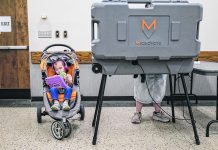Both the local library and school district are looking into a grant that could help provide more internet and technology access to students.
The Federal Communications Commission’s Emergency Connectivity Fund is a $7.17 billion program that will provide funding for eligible schools and libraries to “provide the tools and services their communities need for remote learning during the COVID-19 emergency period.”
This includes Wi-Fi hotspots, modems, routers, laptops, tablet computers and “broadband connectivity purchases for off-campus use.”
The Bartholomew County Public Library is likely to apply for this funding and look at the different eligible items, said Director Jason Hatton. He added that the grant provides a lot of opportunities and fits in with their focus on outreach.
“We have a Bookmobile,” he said. “We have a Book Express that goes around to areas of the community. And then we also just have many staff members who are out and about, doing different pieces and different events and different locations. We go to trailer home parks, we go to apartment complexes, we go to so many locations that the internet is not readily available. Technology is not readily available, and so we’d love to be able to bring those to those entities.”
However, he noted that there are some practical aspects that have to be thought through. For instance, internet and provider capabilities would need to be considered if they decide to apply for hotspot reimbursement, as these devices don’t work as well in certain areas of Bartholomew County. There are also different types of hotspots to consider, as some can offer a larger range, allowing more people to connect.
Library staff are brainstorming ideas and working to create the right programming and proposal, said Hatton.
“We want to make sure that we’re doing this thoughtfully, right, to be able to make sure that we can ask for as much as possible,” he said.
The Bartholomew Consolidated School Corp. plans to apply for the grant as well, said Director of Technology Nick Williams.
“We’re applying mainly for devices, so there’s several tiers of this that we’re putting an application in for,” he said. “And it is not all or nothing. So we may get money for some, all or none.”
The school corp.’s proposed initiatives for the funding include 1:1 devices for kindergarteners.
“We are not 1:1 at the kindergarten level,” Williams said. “We do have options, for kindergarten, to take home, but this would supply Chromebooks that kindergarten students could take home if needed.”
He noted that this will be particularly helpful now that BCSC plans to use eLearning on snow days.
The school corp. also hopes to use grant funds to replace Chromebooks for some students and staff. Williams said that using grant funds to help replace aged-out student devices with new ones would “free up” some of BCSC’s budget. On the staff side, grant funds would mean that the teachers and teaching assistants in question would also receive brand-new devices.
However, the school corp. doesn’t plan on using the grant for Wi-Fi hotspots because they’ve already committed other federal grant funds for this purpose, he said.
While long lead times on technology could mean that new devices take months to be delivered, Williams said that he’s “excited” about the opportunities this grant could provide.
“It may free up money for us to be able to do other things that we haven’t been able to fund,” he said. “…It’s a great opportunity to expand our one-to-one program, to get new devices in students’, teachers’ hands with this government funding.”
The Emergency Connectivity Fund was authorized as part of the American Rescue Plan Act of 2021. The application window opened on June 29 and closes Aug. 13.
“During the application filing window, eligible schools, libraries, and consortia of eligible schools and libraries, can submit requests for funding to purchase eligible equipment and services between July 1, 2021 and June 30, 2022,” the FCC’s website states.
The program’s website also notes that both libraries and schools must confirm that they are only seeking funds for equipment and services for individuals who would otherwise lack the resources required to meet their educational needs.
By recent estimates, there could be as many as 17 million children struggling without the broadband access needed for eLearning, according to the FCC.
“There’s a huge technology gap,” Hatton said. “…We know that. The pandemic has shown that. And so this is a great way to be able to try to close that gap as much as possible.”




